Citroen BERLINGO MULTISPACE RHD 2015 2.G Owner's Manual
Manufacturer: CITROEN, Model Year: 2015, Model line: BERLINGO MULTISPACE RHD, Model: Citroen BERLINGO MULTISPACE RHD 2015 2.GPages: 276, PDF Size: 12.21 MB
Page 141 of 276

Berlingo_2_VP_en_Chap07_Verification_ed02-2014
139
tOtAL & c I tr OË n
Partners in performance and
protecting the environment
Innovation in the search for
performance
For over 40 year, the T
o
T
a
L Research and
Development
departments have developed
for
CITROËN, lubricants to match the latest
technical innovations on CITR
o Ë n vehicles,
both
for competition and for everyday motoring.
For you, this is an assurance that you will
obtain
of the best performance for your engine.
Optimum protection for your
engine
By having your CITR
o Ë n
vehicle serviced with T
o
T
a
L
lubricants, you are contributing
towards
improving the life and
performances
of your engine,
while also protecting the
environment. prefers
Maintenance with tOtAL
cHEcKS
7
Page 142 of 276

140
Berlingo_2_VP_en_Chap07_Verification_ed02-2014
OPEnInG tHE BOnnEt
Bonnet stay
Secure the stay in its location,
identified by a sticker on the right-hand
side of the vehicle, to hold the bonnet
open.
Before closing the bonnet, put the stay
back
in its clip without using excessive
force.
On the outside
Raise the bonnet slightly by reaching
in a flat hand, palm down, to make
access
to the lever easier.
With this hand, push the safety catch
to
the left. Raise the bonnet.
On the inside
Pull the lever below the dashboard
towards you. The bonnet is released.
to close
Lower the bonnet and release it at the
end of its travel. Check that the bonnet
is
secure.
avoid opening the bonnet in strong
winds.
opening the bonnet
Page 143 of 276
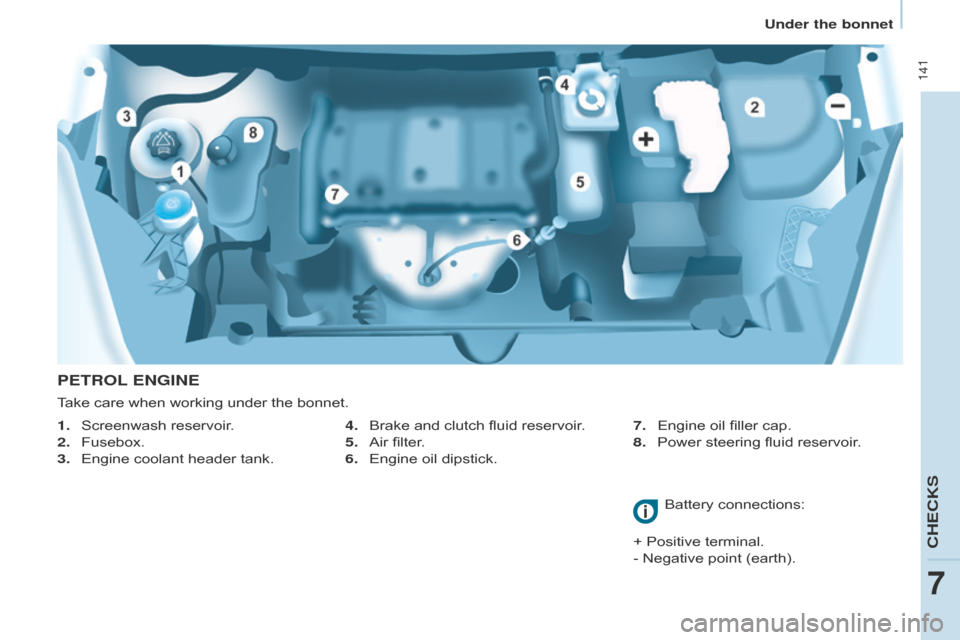
Berlingo_2_VP_en_Chap07_Verification_ed02-2014
141
PEtrOL EnGInE
1. Screenwash reservoir.
2.
Fusebox.
3.
Engine
coolant header tank.
Battery
connections:
+
Positive terminal.
-
Negative point (earth).
Take
care when working under the bonnet.
4. Brake and clutch fluid reservoir.
5.
Air
filter.
6.
Engine
oil dipstick.7.
Engine oil filler cap.
8.
Power
steering fluid reservoir.
Under the bonnet
CHECkS
7
Page 144 of 276

Berlingo_2_VP_en_Chap07_Verification_ed02-2014
142
dIESEL EnGInE
4. Brake and clutch fluid reservoir.
5.
Air
filter.
6.
Engine
oil dipstick. 7.
Engine oil filler cap.
8.
Power
steering fluid reservoir.
9.
Priming
pump.
1.
Screenwash
reservoir.
2.
Fusebox.
3.
Engine
coolant
header
tank.
Battery
connections:
+
Positive terminal.
-
Negative point (earth).
Take
care
when
working
under
the
bonnet.
Under the bonnet
Page 145 of 276
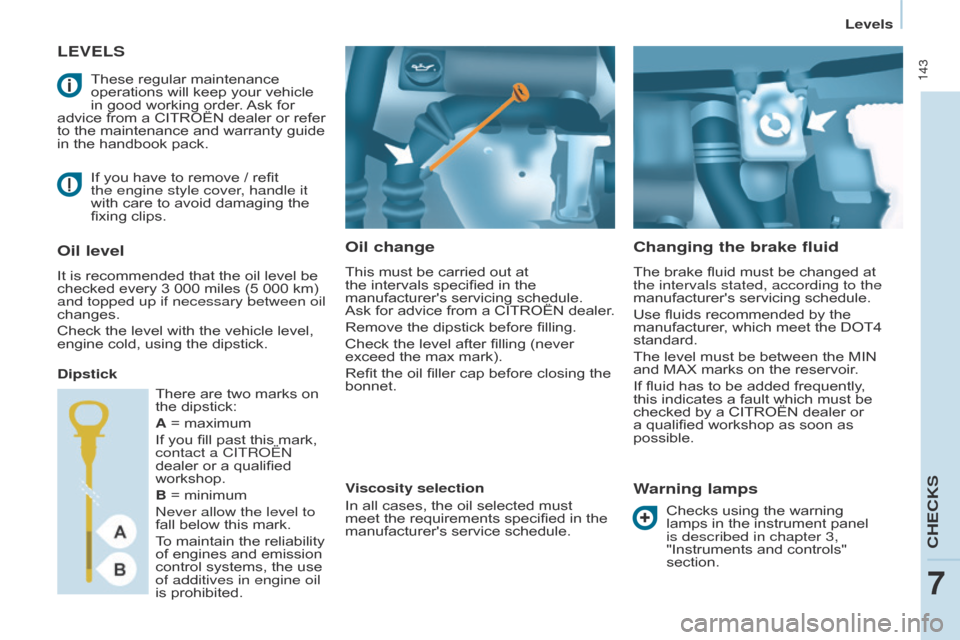
Berlingo_2_VP_en_Chap07_Verification_ed02-2014
143
LEVELSOil change
This must be carried out at the intervals specified in the
manufacturer's
servicing schedule.
Ask
for
advice
from
a
CITROËN
dealer
.
Remove
the dipstick before filling.
Check
the level after filling (never
exceed
the max mark).
Refit
the oil filler cap before closing the
bonnet.
changing the brake fluid
The brake fluid must be changed at the intervals stated, according to the
manufacturer's servicing schedule.
Use
fluids recommended by the
manufacturer
, which meet the DOT4
standard.
The
level must be between the MIN
and
MAX marks on the reservoir.
If
fluid has to be added frequently,
this
indicates a fault which must be
checked
by a CITROËN dealer or
a
qualified workshop as soon as
possible.
Warning lamps
If you have to remove / refit
the engine style cover , handle it
with
care to avoid damaging the
fixing
clips.
Oil level
It is recommended that the oil level be checked every 3 000 miles (5 000 km)
and topped up if necessary between oil
changes.
Check
the level with the vehicle level,
engine
cold, using the dipstick.
d
ipstick
Viscosity selection
In
all cases, the oil selected must
meet
the requirements specified in the
manufacturer's
service schedule.
These
regular maintenance
operations
will keep your vehicle
in
good working order.
Ask
for
advice
from a CITROËN dealer or refer
to
the maintenance and warranty guide
in
the handbook pack.
Checks using the warning
lamps
in the instrument panel
is described in chapter 3,
"Instruments
and controls"
section.
There
are two marks on
the
dipstick:
A
= maximum
If
you fill past this mark,
contact a CITR
o Ë n
dealer
or a qualified
workshop.
B
= minimum
n
ever allow the level to
fall
below this mark.
To
maintain the reliability
of
engines and emission
control
systems, the use
of additives in engine oil
is
prohibited.
Levels
CHECkS
7
Page 146 of 276
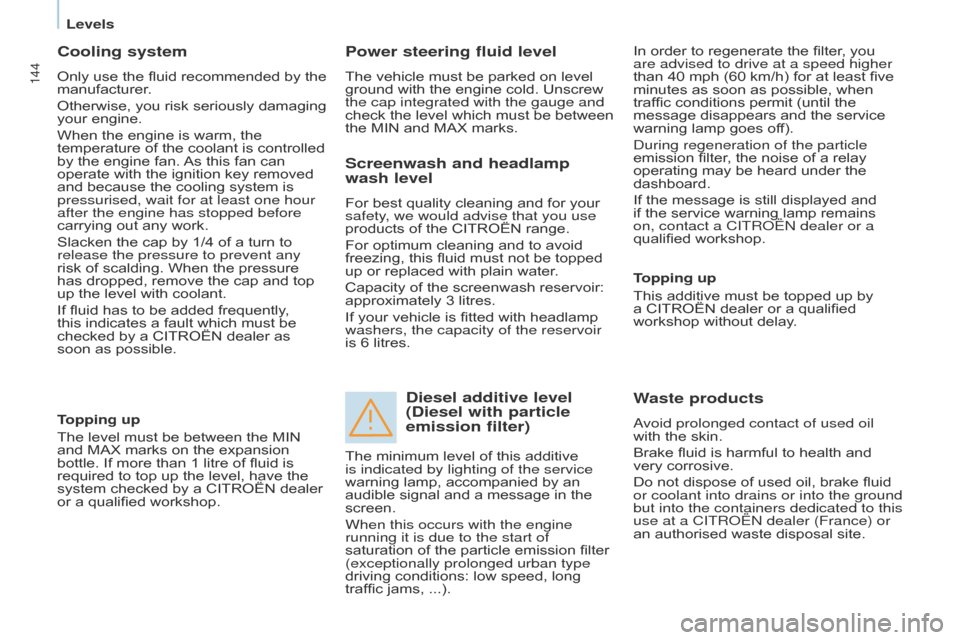
Berlingo_2_VP_en_Chap07_Verification_ed02-2014
144
cooling system
Only use the fluid recommended by the manufacturer.
Otherwise,
you risk seriously damaging
your
engine.
When
the engine is warm, the
temperature
of the coolant is controlled
by
the engine fan.
As
this fan can
operate
with the ignition key removed
and
because the cooling system is
pressurised, wait for at least one hour
after the engine has stopped before
carrying
out any work.
Slacken
the cap by 1/4 of a turn to
release the pressure to prevent any
risk
of scalding. When the pressure
has
dropped, remove the cap and top
up
the level with coolant.
If
fluid has to be added frequently,
this
indicates a fault which must be
checked
by a CITROËN dealer as
soon
as possible.
Power steering fluid level
The vehicle must be parked on level ground with the engine cold. Unscrew
the cap integrated with the gauge and
check
the level which must be between
the
MIN and MAX marks. In
order to regenerate the filter, you are advised to drive at a speed higher
than
40 mph (60 km/h) for at least five minutes
as soon as possible, when
traffic
conditions permit (until the
message
disappears and the service
warning
lamp goes off).
d
uring regeneration of the particle
emission
filter, the noise of a relay
operating
may be heard under the
dashboard.
If
the message is still displayed and
if
the service warning lamp remains
on, contact a CITR
o Ë n dealer or a
qualified
workshop.
topping up
The
level
must
be
between
the
MIN
and
MAX
marks
on
the
expansion
bottle.
If
more
than
1
litre
of
fluid
is
required
to
top
up
the
level,
have
the
system
checked
by
a
CITROËN
dealer
or
a
qualified
workshop.
Screenwash and headlamp
wash level
For best quality cleaning and for your safety , we would advise that you use
products
of the CITROËN range.
For
optimum cleaning and to avoid
freezing,
this fluid must not be topped
up
or replaced with plain water.
Capacity
of the screenwash reservoir:
approximately
3 litres.
If
your vehicle is fitted with headlamp
washers, the capacity of the reservoir
is
6 litres.
diesel additive level
( d iesel with particle
emission filter)
topping up
This additive must be topped up by
a
CITROËN dealer or a qualified
workshop
without delay.
Waste products
avoid prolonged contact of used oil
with the skin.
Brake
fluid is harmful to health and
very
corrosive.
Do
not dispose of used oil, brake fluid
or coolant into drains or into the ground
but into the containers dedicated to this
use at a CITR
o Ë n dealer (France) or
an
authorised waste disposal site.
The
minimum
level
of
this
additive
is indicated by lighting of the service
warning
lamp,
accompanied
by
an
audible
signal
and
a
message
in
the
screen.
When this occurs with the engine
running it is due to the start of
saturation
of
the
particle
emission
filter
(exceptionally prolonged urban type
driving
conditions:
low
speed,
long
traffic
jams,
...).
Levels
Page 147 of 276
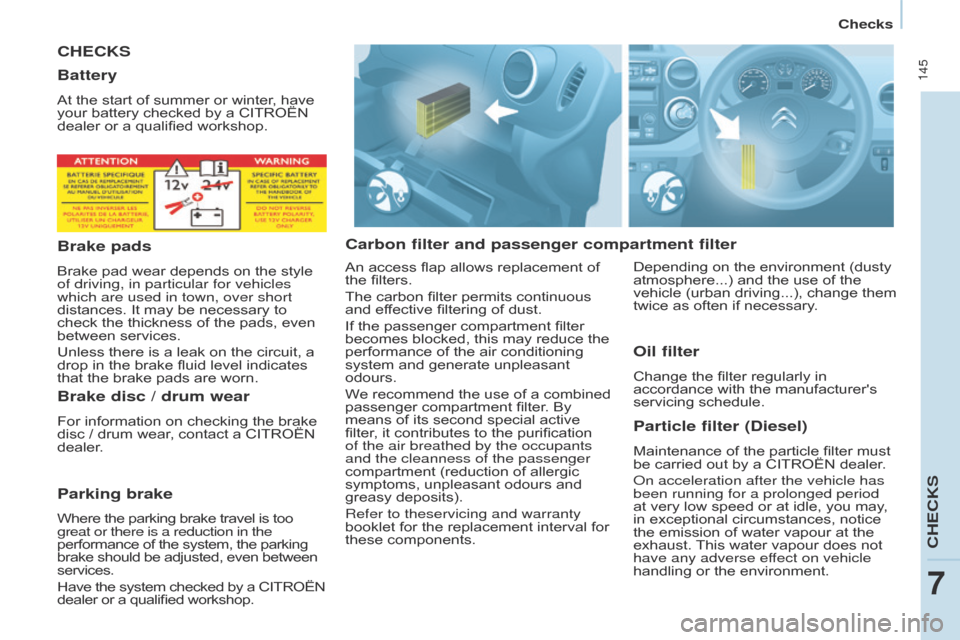
Berlingo_2_VP_en_Chap07_Verification_ed02-2014
145
cHEcKS
c
arbon filter and passenger compartment filterParticle filter (
d iesel)
Maintenance of the particle filter must be carried out by a CITROËN dealer.
o
n acceleration after the vehicle has
been running for a prolonged period
at
very low speed or at idle, you may,
in
exceptional circumstances, notice
the
emission of water vapour at the
exhaust.
This
water vapour does not
have any adverse ef
fect on vehicle
handling
or the environment.
Battery
At the start of summer or winter, have your battery checked by a CITROËN
dealer
or a qualified workshop.
Brake pads
Brake pad wear depends on the style of driving, in particular for vehicles
which are used in town, over short
distances.
It may be necessary to
check
the thickness of the pads, even
between
services.
Unless
there is a leak on the circuit, a
drop
in the brake fluid level indicates
that
the brake pads are worn.
Brake disc / drum wear
For information on checking the brake disc / drum wear, contact a CITROËN
dealer
.
Parking brake
Where the parking brake travel is too great or there is a reduction in the
performance
of the system, the parking
brake
should be adjusted, even between
services.
Have
the system checked by a CITROËN
dealer
or a qualified workshop.
Oil filter
Change the filter regularly in accordance with the manufacturer's
servicing
schedule.
An
access
flap
allows
replacement
of
the
filters.
The
carbon
filter
permits
continuous
and
effective
filtering
of
dust.
If
the
passenger
compartment
filter
becomes
blocked,
this
may
reduce
the
performance
of
the
air
conditioning
system
and
generate
unpleasant
odours.
W
e
recommend
the
use
of
a
combined
passenger
compartment
filter.
By
means
of
its
second
special
active
filter
,
it
contributes
to
the
purification
of the air breathed by the occupants
and the cleanness of the passenger
compartment
(reduction
of
allergic
symptoms,
unpleasant
odours
and
greasy
deposits).
Refer to theservicing and warranty
booklet
for
the
replacement
interval
for
these
components. Depending
on the environment (dusty
atmosphere...)
and the use of the
vehicle
(urban driving...), change them
twice
as often if necessary.
Checks
CHECkS
7
Page 148 of 276

Berlingo_2_VP_en_Chap07_Verification_ed02-2014
146
Bleeding water from the diesel
filter Manual gearbox
Have the level checked in accordance with the
manufacturer's servicing schedule.
Only use products recommended by CITRo Ë n or products
of
equivalent quality and
specification.
In
order to optimise the operation
of
units as important as the braking
system,
CITROËN selects and offers
specific
products.
In
order to avoid damaging the
electrical units, high pressure washing
to
clean the engine compartment is
strictly
prohibited.
After
washing the vehicle dampness,
or
in
winter, ice may form on the brake
discs
and pads: braking efficiency may
be
reduced. Make some light brake
applications to dry and de-ice the
brakes.
If
this
warning
lamp
comes
on,
bleed
the
filter.
Otherwise
bleed
regularly
each
time
the
engine
oil
is
changed.
H
d
i engines use advanced
technology.
All
work
requires
special training, which is assured
by
a
CITROËN
dealer.
Depending
on
country
of
sale.
To drain the water, unscrew the bleed
screw
located
on
the
filter.
o
perate until all of the water no longer
flows
in
the
transparent
pipe,
then
tighten
the
bleed
screw.
checks
Page 149 of 276

Berlingo_2_VP_en_Chap07_Verification_ed02-2014
147
FILLInG WItH FuEL
Low fuel level
Filling
The fuel tank must be filled with the
engine off.
-
Open
the fuel filler flap.
-
Insert
the key, then turn it a quarter
turn.
-
Remove
the cap and hook it onto
the clip located on the inside of the
flap.
When
filling with fuel, a
mechanical
system prevents
opening
of the left-hand side door.
When
the fuel filler flap is open, ensure
that
no one tries to slide this door.
Once
the flap has been closed, the
sliding
side door may jam, push the
door
to close it then open it.
When
the
minimum
fuel
tank
level is reached, this warning
lamp
comes
on.
You then have
approximately 8 litres of
fuel
remaining.
Fill
up
without
delay
to
avoid
running
out
of
fuel.
Never
risk
driving
until
you
run
out
of
fuel
as
this
may
damage
the
emissions
control
and
injection
systems. A
label affixed to the inside of the flap
reminds
you of the type of fuel to be
used.
Y
ou must fill with at least 5 litres of fuel
for
it to be registered by the fuel gauge.
When
the fuel filler cap is opened,
there
may be a slight air suction noise.
This
vacuum is entirely normal and is
due
to the sealing of the fuel circuit.
When
filling the fuel tank, do not
continue after the 3rd cut-off of the
nozzle.
This
could
cause malfunctions.
The
capacity
of
the
fuel tank is
approximately
60
litres.
-
After
filling
the
fuel tank, lock the
cap
and
close
the flap.
Fuel used for petrol engines
The petrol engines are compatible with E10 bio-petrol (containing 10 %
ethanol), conforming to European
standards
EN 228 and EN 15376.
E85 type fuels (containing up to 85 %
ethanol) are reserved exclusively for
vehicles
marketed for the use of this
type
of fuel (BioFlex vehicles).
The
quality
of the ethanol must comply with
European
standard EN 15293.
Fuel
cHEcKS
7
Page 150 of 276
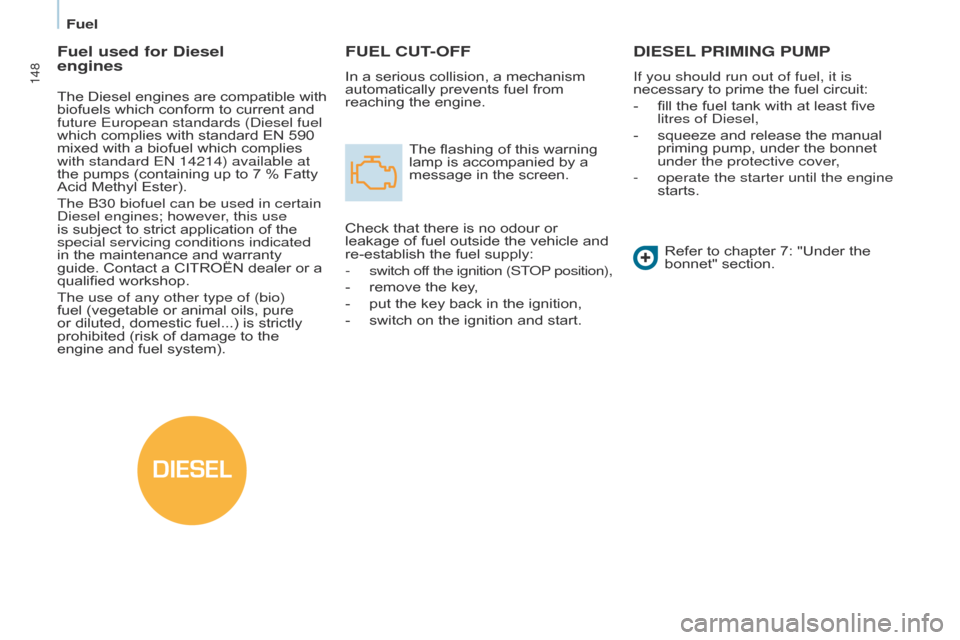
DIESEL
Berlingo_2_VP_en_Chap07_Verification_ed02-2014
148
FuEL cut-OFF
In a serious collision, a mechanism automatically prevents fuel from
reaching
the engine.
The
flashing of this warning
lamp
is accompanied by a
message
in the screen.
Check
that there is no odour or
leakage
of fuel outside the vehicle and
re-establish
the fuel supply:
-
switch of
f the ignition (ST
o
P position),
-
remove
the key,
-
put
the key back in the ignition,
-
switch
on the ignition and start.
dIESEL PrIMInG PuMP
If you should run out of fuel, it is
necessary to prime the fuel circuit:
-
fill
the fuel tank with at least five
litres of
d iesel,
-
squeeze
and release the manual
priming
pump, under the bonnet
under the protective cover
,
-
operate the starter until the engine
starts. Refer
to chapter 7: "Under the
bonnet"
section.
Fuel used for diesel
engines
The Diesel engines are compatible with biofuels
which conform to current and
future European standards (
d iesel fuel
which
complies with standard EN 590
mixed
with a biofuel which complies
with standard E
n 14214) available at
the
pumps (containing up to 7 % Fatty
Acid
Methyl Ester).
The B30 biofuel can be used in certain
d
iesel engines; however, this use
is
subject to strict application of the
special servicing conditions indicated
in
the maintenance and warranty
guide.
Contact a CITROËN dealer or a
qualified
workshop.
The use of any other type of (bio)
fuel
(vegetable or animal oils, pure
or
diluted, domestic fuel...) is strictly
prohibited
(risk of damage to the
engine
and fuel system).
Fuel